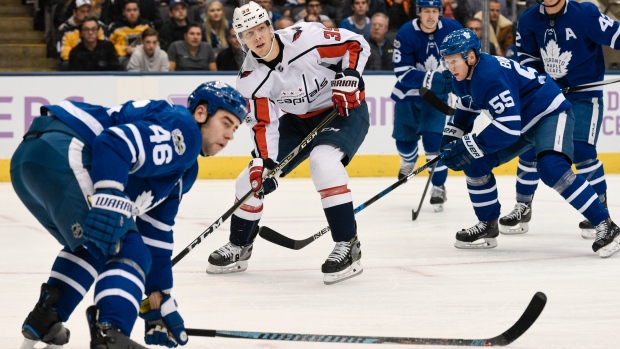Jan 4, 2018
Leafs can’t stand pat on the blueline
Toronto needs to add a top-four defenceman before the trade deadline to meet the high expectations the team is facing this season, Travis Yost writes.
By Travis Yost

Regardless of their struggles over the last 10 games (3-6-1), the Toronto Maple Leafs are in a pretty good spot.
Some of this has to do with banking so many points early in the year. Some of this has to do with a chunk of their losing streak coming with core players like Auston Matthews and Nikita Zaitsev sidelined. Some of this has to do with how little competition the Atlantic Division has to offer this season.
Even during this tough stretch, it’s hard to envision any scenario where the Leafs miss the playoffs. The Leafs are currently third in the Atlantic, one spot ahead of a Florida Panthers squad that is playing at an 82-point pace – 14 points behind Toronto. That’s the good news.
The bad news is that there is something of a stench around their overall play of late. Toronto is getting outshot pretty consistently during this stretch (a rarity in the Mike Babcock era), with about 49 per cent of the play in Toronto’s favour. And, obviously, the team has been outscored in the same interval – they are -6 in 5-on-5 goals and -3 across all situations.
Part of this has to do with the team’s shaky blueline. I’ve argued for some time now that Toronto can’t simply stand pat for much longer. The idea that the core pieces around the team would be all homegrown was fun, but the defence has let the Leafs down on more than one occasion. I suspect Babcock feels the same way.
Last week’s analysis on blueline deployment across the Canadian markets turned up something very interesting – there isn’t a single player Toronto’s head coach feels comfortable enough with to deploy in all situations. It’s good that he has a mix of players with varying skills, but it’s problematic that the coach doesn’t have a single guy he can lean on in high-leverage situations.
Expanding on this point from last week, I went ahead and looked at game-by-game ice time allocation for each Leafs defenceman. Below, you have each defender’s rank in ice time by game, with grey cells indicating that the player was deployed with top-pairing minutes. (These numbers are 5-on-5 only, but it’s worth noting that even when you include special teams, the numbers are reasonably similar.)
We can draw a few conclusions from this. One, Jake Gardiner is clearly Babcock’s most trusted defender. Two, Babcock’s also recognized that Roman Polak is probably a guy who needs to be sheltered down the lineup at this point in his career. Three, defenders two through six are a muddied mess.
I find it particularly noteworthy that Morgan Rielly has really ceded ice time to others (notably Zaitsev and Ron Hainsey) this season. And, again, that’s true if you are looking at 5-on-5 like above or in all situations – on the latter, he’s down close to two minutes from his deployment during the 2015-16 season.
The Zaitsev finding is the most prominent, though. The Leafs committed in a big way to a guy who really didn’t have much of a resume, offering him seven years and $31.5 million after one NHL season. The bet, I suspect, was that the team could win on his contract if he continued developing over the next couple of seasons. And, even in a worst-case scenario, he seemed like a solid bet for second-pairing duty. At $4.5 million AAV, that’s not crazy.
He’s having an okay season – he’s -89 in shots but +5 in goals, and has sucked up a bunch of penalty-kill minutes for a team with few shutdown options. That could very well be good enough for a second-pairing guy, except the Leafs have been playing him much more than that. He’s actually seeing top-pair minutes in over 55 per cent of his games, which is easily the second most on the roster.
The game-by-game distribution of ice time is interesting for many of the same reasons – you can see that Gardiner and Zaitsev are eerily similar, and guys like Hainsey have random games where they are played more than anyone else.
The defence by committee approach, by and large, has worked for Toronto. They made the playoffs last year and will again this year. But if you hold them to a new expectation – a higher expectation, one that would entail playoff victories – you start to wonder how the piecemeal approach gets it done. Especially after last year’s Stanley Cup playoffs, where three of the four conference finalists had a specific top pair they leaned on in extensive minutes to advance.
For this reason, I anticipate that the Leafs will continue hunting for options at the trade deadline. This is a team with an abundance of assets they could flip if a top-four type shakes loose. The only question is who.

